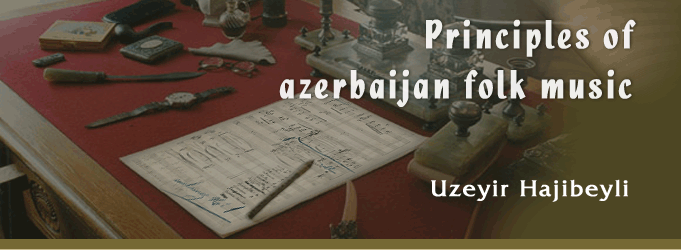

Part two
PRINCIPLES OF COMPOSING MUSIC
IN AZERBAIJANI MODES IN FOLK STYLE
I. STRUCTURE OF PERFECT QUARTES
The modes where the scales form successive perfect quartes, are the following:1) "Rast", 2) "Shur", and 3) "Segah".
In the scales consisting of successive series of perfect quartes, the main quarte marks are the tones, which take the position of the first degree in the tetrachord 1-1-1/2.
These degrees are called the main tones, and they implement tonic function in the mode "Rast".
1. Composing music in the mode "Rast"
A. Diapason of the mode scale"Rast"
Three equal tetrachords structured by formula 1 - 1 - 1/2 and connected by chain combination form the scale of the "Rast" mode. The first degree of the medial tetrachord in this scale is a modal tonic. With the first octave tonic do the scale of the "Rast" is presented in the following way:
В. Modal functions of degrees and permissible leaps
All the degrees of the "Rast" modal scale are subordinated to the tonic. These tones are intended to "serve" the tonic and intensify its dominant position in the melody. Therefore, the third, the quarte, and the quinte leaps are not permitted from the each degree. For example: a quarte leap from the sub-mediant to the supertonic la-rе serves the tonic, but a quarte leap from the subtonic to the third of the tonic si-mi has a divergent intonation with a tendency to transform the third of the tonic mi into an independent tonic, that is why this leap is forbidden.
1-st degree functions in the above mode scale "Rast"as a lower quarte of the tonic. Gradual move from this degree is possible in the ascending direction. The lower quarte is a foothold for the leap into the tonic and supertonic.
2-nd degree functions as a mediant of the tonic. It prepares a supertonic and the keynote subtonic: upper one with a leap to the major second, and lower one with a leap to the quarte. Leaps from this degree are possible directly to the tonic and supertonic of the keynote.
3-rd degree functions as a keynote subtonic . Before the tonic leap it can step one second downwards. From the subtonic it is possible to make a leap only to the supertonic.
4-th degree, the main tone, functions as a tonic. The tonic allows leaps in the ascending direction to the third, the upper quarte, the quinte and the supertonic of the quinte; in the descending direction to the mediant and the lower quarte.
5-th degree functions as a supertonic. Leaps from this degree are possible upwards - to the tonic quarte and quinte, downwards - to the subtonic, to the tonic mediant and to the lower quarte of the tonic.
6-th degree functions as a tonic third. Leaps from this degree are allowed: upwards -to the tonic quinte, downwards - to the tonic.
7-th degree functions as an upper quarte of the tonic. Leaps from this degree are allowed: upwards -to the supertonic of the quinte and downwards - to the supertonic of the keynote and to the tonic.
8-th degree functions as a tonic quinte. Leaps from this degree are allowed: downwards - to the third, to the supertonic of the keynote and to the tonic.
9-th degree functions as a supertonic of the keynote quinte. Only one leap downwards to the supertonic of the keynote is allowed from this degree.
10-th degree acts as a boundary tone of the mode scale. Leaps from this degree are not allowed, gradual movement is possible only in the descending direction.
[ Rast: pages 1 2 3 4 5 6 ]
| Rast | Shur | Segah |
